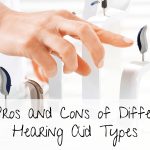Hearing aids have come a long way in recent years, and now, more than ever, most models offer a high enough sound quality that listening to music can be as enjoyable an experience as it was before hearing loss became an issue.
That said, hearing aid users sometimes struggle to find a set of headphones that works for them. As for people with no hearing loss issues, volume should be kept to a minimum to avoid noise-induced hearing loss from headphone use, and it is recommended that you talk to your audiologist about headphones before experimenting with them.
Headphones for the Two Main Types of Hearing Aid
The two main types of hearing aids are behind-the-ear (BTE) and receiver-in-the-canal (RIC). Both types keep the bulk of the hearing aid behind the ear, though BTE models actually have the microphone on the larger part of the unit, outside the ear canal (only the speaker sits inside the ear canal with BTE models). This means headphones that project their sound into the ear canal will miss the microphone entirely, and for that reason it is recommended to seek the over-the-ear type of headphone, rather than in-ear or on-the-ear types.
Even in the world of over-the-ear headphones, some will have a larger surround (the part that fits over the ear) than others, so it’s important to try out a few models to see which will most comfortably fit over your ear while your hearing aids are in.
Another issue can be feedback between the headphone speaker and the hearing aid. Even if you find a model that fits fully over your ear, if the headphone speaker is less than about 1 centimeter from your hearing aid microphone, you can end up with feedback issues. So when you’re trying out different models, be sure to actually play some music through them to make sure they won’t feed back!
If your hearing aids are the RIC type, you may be able to use on-ear headphones. This type will look similar to over-the-ear models, except that rather than resting against the sides of the head and totally sealing the ear, they will rest against the ear itself. Some people consider these more comfortable as they leave most of the ear open to the air, though you may also have more issues with background noise and slippage, and they tend to provide somewhat lower sound quality than over-the-ear models.
Headphones for Other Types of Hearing Aids
Other types of hearing aids include in-the-canal (ITC), completely-in-the-canal (CIC), and invisible-in-the-canal (IIC) models. ITC users can comfortably use most on-ear headphones, and if your hearing aids are CIC, your options will be a little wider still. While over-the-ear or on-ear headphones are probably your best bet, if your CIC hearing aids sit deep enough in the canal, you may be able to use earphones, which would sit inside the canal right behind your hearing aids. The advantage to using earphones is that they are much smaller and easier to travel with.
IIC models sit deeply enough in the ear canal that any headphone options become available, including wireless earbuds. Your only concern with IIC’s will be narrowing down your options! Any set of headphones or earbuds should be compatible with IIC hearing aids.
Noise-Canceling Headphones
Especially a great option for travelers, noise-canceling headphones use active technology to cancel out ambient sound. This tends to work best when the ambient sound is consistent, like the noise in an airplane cabin. While the active technology (which can be turned on and off) frequently creates a slight hissing sound, noise-canceling headphones can allow you to keep the volume lower on your personal listening device while still being able to hear the content. You can even use the noise-canceling technology without playing any content, just to get some peace and quiet! Noise-canceling headphones are available in all styles, so whichever style you choose to work best with your hearing aids, there is a noise-canceling option available.
Other Concerns
While audiophile-grade headphones might be appealing, these will require hearing aids of exceptional sound quality. Remember that using headphones and hearing aids at the same time involves three stages of transduction (converting sound from mechanical to electronic energy or vice versa). Even the best systems will suffer some degradation in sound quality. One option is for hearing aid users to remove their hearing aids and turn up the volume on their headphones, though it is highly recommended to consult an audiologist before taking this approach.
Bluetooth Hearing Aids with FitHearing
For the best sound quality, why not ditch the headphones and invest in a pair of Bluetooth hearing aids? There are many advanced hearing aid options that offer excellent sound quality and with a Bluetooth connection, you will be able to stream audio directly to your hearing aids from the playing device.






